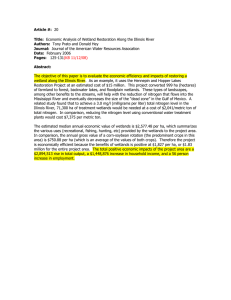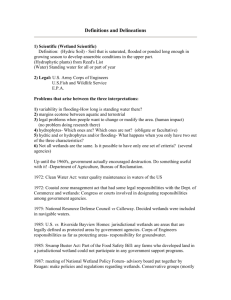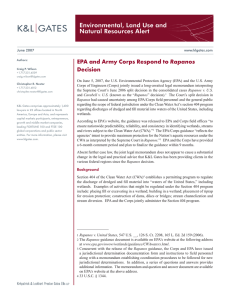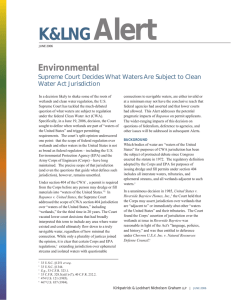Environs Supreme Court Offers No Clear Guidance in Wetlands Decision Breaking
advertisement
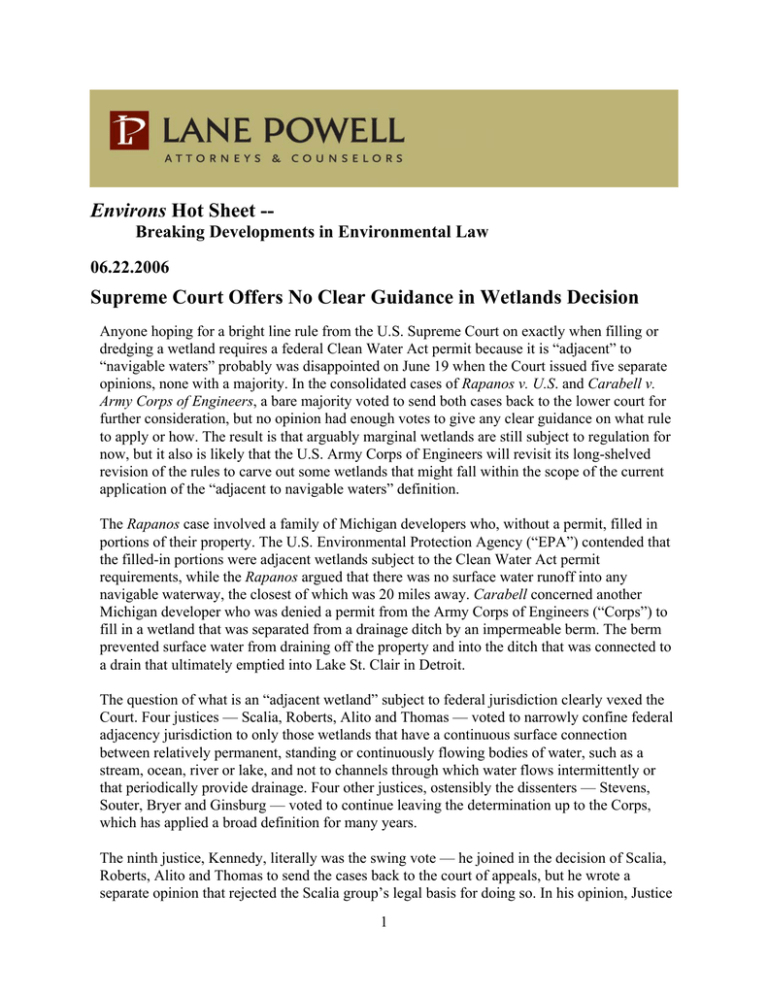
Environs Hot Sheet -Breaking Developments in Environmental Law 06.22.2006 Supreme Court Offers No Clear Guidance in Wetlands Decision Anyone hoping for a bright line rule from the U.S. Supreme Court on exactly when filling or dredging a wetland requires a federal Clean Water Act permit because it is “adjacent” to “navigable waters” probably was disappointed on June 19 when the Court issued five separate opinions, none with a majority. In the consolidated cases of Rapanos v. U.S. and Carabell v. Army Corps of Engineers, a bare majority voted to send both cases back to the lower court for further consideration, but no opinion had enough votes to give any clear guidance on what rule to apply or how. The result is that arguably marginal wetlands are still subject to regulation for now, but it also is likely that the U.S. Army Corps of Engineers will revisit its long-shelved revision of the rules to carve out some wetlands that might fall within the scope of the current application of the “adjacent to navigable waters” definition. The Rapanos case involved a family of Michigan developers who, without a permit, filled in portions of their property. The U.S. Environmental Protection Agency (“EPA”) contended that the filled-in portions were adjacent wetlands subject to the Clean Water Act permit requirements, while the Rapanos argued that there was no surface water runoff into any navigable waterway, the closest of which was 20 miles away. Carabell concerned another Michigan developer who was denied a permit from the Army Corps of Engineers (“Corps”) to fill in a wetland that was separated from a drainage ditch by an impermeable berm. The berm prevented surface water from draining off the property and into the ditch that was connected to a drain that ultimately emptied into Lake St. Clair in Detroit. The question of what is an “adjacent wetland” subject to federal jurisdiction clearly vexed the Court. Four justices — Scalia, Roberts, Alito and Thomas — voted to narrowly confine federal adjacency jurisdiction to only those wetlands that have a continuous surface connection between relatively permanent, standing or continuously flowing bodies of water, such as a stream, ocean, river or lake, and not to channels through which water flows intermittently or that periodically provide drainage. Four other justices, ostensibly the dissenters — Stevens, Souter, Bryer and Ginsburg — voted to continue leaving the determination up to the Corps, which has applied a broad definition for many years. The ninth justice, Kennedy, literally was the swing vote — he joined in the decision of Scalia, Roberts, Alito and Thomas to send the cases back to the court of appeals, but he wrote a separate opinion that rejected the Scalia group’s legal basis for doing so. In his opinion, Justice 1 Kennedy articulated a slightly narrower interpretation of Clean Water Act wetlands jurisdiction than the Corps’ traditional view, one that requires a showing that a wetland significantly affects the chemical, physical and biological integrity of other navigable waters. As Justice Kennedy’s opinion and the four dissenters are somewhat allied, it appears a continuing narrow majority of the Supreme Court supports a broad but ambiguous definition of “adjacent wetlands.” For the time being, however, property owners, developers and opponents still have no reasonably certain basis for predicting which “adjacent” wetlands are subject to the Clean Water Act permit requirements. The upshot of the Supreme Court’s decisions in Rapanos and Carabell is that wetlands adjacency issues will continue to be left to the lower courts to decide on a case-by-case basis, which is a prescription for more litigation and greater expense for all involved. For wetlands subject to state jurisdiction, the Supreme Court’s decision will mean little, if any, change. Under Oregon law, the Division of State Lands administers wetlands issues and its removal-fill jurisdiction includes some artificially-created wetlands and artificially-created stream channels or ditches with food and game fish and a connection to other natural waters. Meanwhile, in Washington, the Department of Ecology has jurisdiction over any project calling for fill or alteration of a wetland determined by the Corps to be isolated (i.e., outside the federal Clean Water Act jurisdiction). Thus, no matter what happens in the wake of Rapanos, isolated wetlands in Washington are still subject to regulation based on the broad authority of the State Water Pollution Control Act. For more information, please contact the Environmental Law Practice Group at: Lane Powell PC: (206) 223-7000 Seattle (503) 778-2100 Portland environs@lanepowell.com www.lanepowell.com We provide Environs Hot Sheet as a service to our clients, colleagues and friends. It is intended to be a source of general information, not an opinion or legal advice on any specific situation, and does not create an attorney-client relationship with our readers. If you would like more information regarding whether we may assist you in any particular matter, please contact one of our lawyers, using care not to provide us any confidential information until we have notified you in writing that there are no conflicts of interest and that we have agreed to represent you on the specific matter that is the subject of your inquiry. © 2006 Lane Powell PC Seattle - Portland - Anchorage - Olympia - London 2

